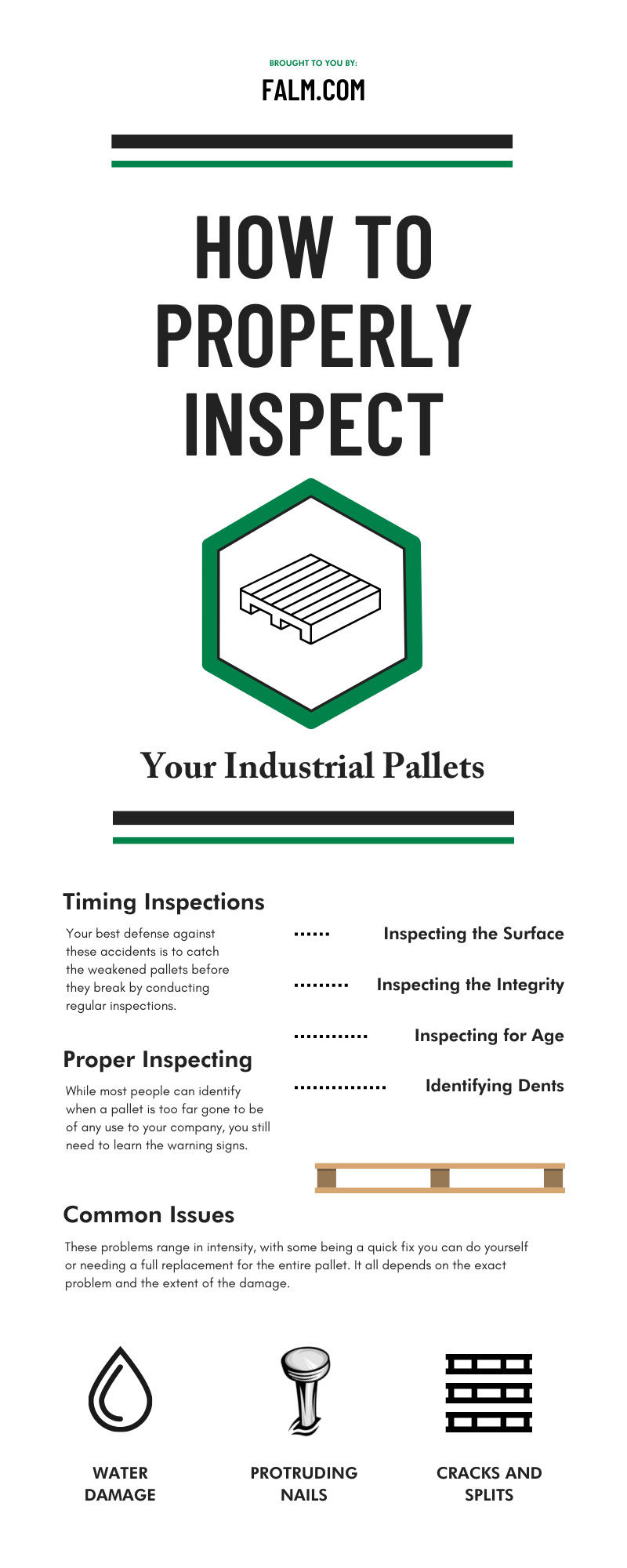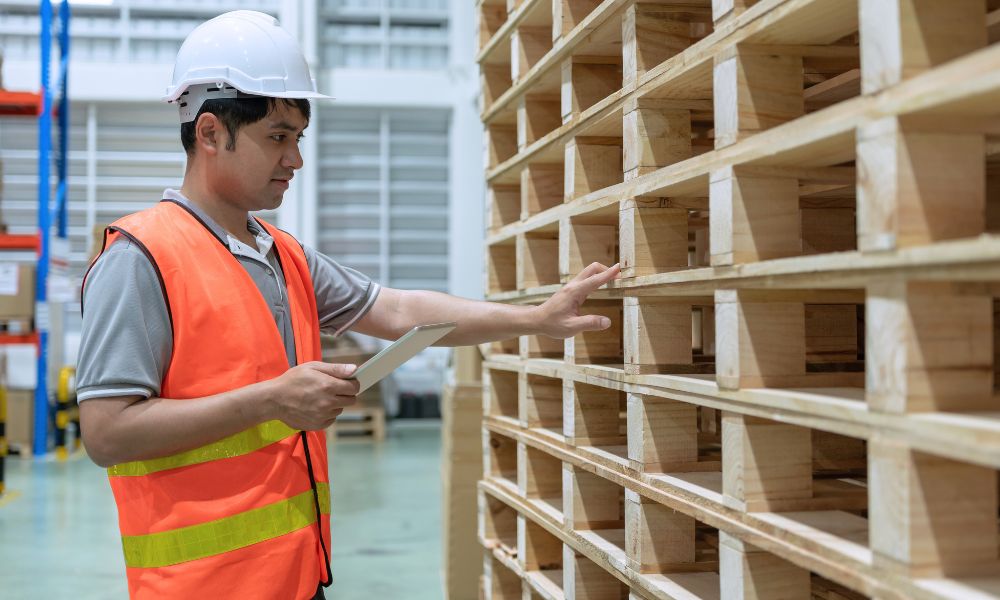Industrial pallets are a necessary tool for various businesses all over the world. Storing and shipping become a lot easier with pallets, and organizing your stock is simple with these pallets. However, pallets are just like any other type of equipment in the workplace—they wear down over time as you use them. That’s why regular and thorough inspections are an important part of using pallets. This guide will help you learn how to properly inspect your industrial pallets.
Timing Inspections
One of the most important things you can do for your pallets is to run regular inspections. Pallets break down and can cause a lot of harm to both workers and property should something go awry. Your best defense against these accidents is to catch the weakened pallets before they break by conducting regular inspections. For most, inspecting your pallets once every 30 days should catch most problems early enough.
Rotating Schedule
Pulling your entire stock of pallets for one day a month to inspect each one is not a viable business decision. This process would put a stop to all your operations and require a lot of resources and labor. Instead, you should use a rotating schedule, inspecting just a small portion of your pallets every few days. This method keeps most of your pallets in operation while still allowing you to check every pallet in a month’s time.
Proper Inspecting
While most people can identify when a pallet is too far gone to be of any use to your company, you still need to learn the warning signs. You want to catch problems before they worsen and become dangerous for your employees, which means learning how to run proper inspections is essential. This next section will cover how to inspect the different parts of your pallets for damage and identify signs of wear or potential hazards.
Inspecting the Surface
The first thing you need to do is check the surface of your pallet. Focus on the top of your pallet, checking for any cracks or warping in the material, which indicates weakness and wear. The cracks signify that it’s time to replace your pallet, as it will only break down quicker due to the existing damage. After you check the top of the pallet, make sure you look at the surfaces underneath and on the sides as well.
Inspecting the Integrity
The structure of a pallet is important, as each part supports the whole pallet. Anything that weakens a single part of the pallet can result in more damage later. Check your pallet to ensure that all the parts are in place and connect as they should. Wiggling and loose parts can mean your pallet is weakening and may lead to more problems later during use.
Inspecting for Age
Pallet materials are durable and long-lasting, but they do age and wear down over time. You should keep a record of the manufacturing date of your pallets and replace them when they get too old or show signs of aging. Stains or warping can indicate aging, but certain materials will show other unique signs of aging. For example, wood may splinter or dry out as time goes on, but you can always invest in custom wood pallets to have high-quality tools.
Identifying Dents
One of the more regular causes of damage to pallets is rough use or blunt force, both of which can occur with regular use. It’s nearly impossible to prevent all damage during regular use of pallets, which is why it’s important to keep inspecting them. One of the biggest signs of damage presents as dents in the surface of the pallet, where something struck the pallet during use. While not every dent indicates risk, identifying the dents can help you catch worn-down pallets before they become safety hazards.
Common Issues
To help you better prepare for your inspections and to learn more about the issues you should look out for in your own pallets, here’s a quick look at some of the common issues. These problems range in intensity, with some being a quick fix you can do yourself or needing a full replacement for the entire pallet. It all depends on the exact problem and the extent of the damage.
Protruding Nails
One of the more commonplace issues with pallets stems from the nails or screws that hold the pallets together. With time, these fasteners will start to protrude. This issue can cause all sorts of additional problems, as the nails become obstacles and hazards for products and workers. However, protruding fasteners are simple to address. You can replace the nails or hammer/screw them back into place in most situations.
Water Damage
Pallet storage is very important, and improper storage or accidents can cause irreparable damage to your pallets. One of the worst types of damage is water damage, as you can’t repair the damage in most cases. While wooden pallets are more susceptible to water damage, you should check every type of pallet for water issues. If you do discover water damage on your wood pallets, you can always purchase new custom wood pallets to replace them.
Cracks and Splits
Cracks and splits in your pallets can spell the end for that pallet. These cracks can worsen if you continue to use the pallet, possibly leading to injuries and product damage as the pallet breaks down. While you may be able to fix some cracks and splits, these repairs are often not worth the risk since an unstable pallet will still be a workplace hazard. Purchasing new pallets when cracks present themselves can save your business money in the long run.
Testing Your Pallets
You should take the time to test your pallets during your inspections. You want to ensure they’re in proper form before you put them on the work floor. In most cases, your best bet is to run these tests when you receive the pallet and during subsequent inspections. The first test is a load-bearing test, which ensures your pallet can hold the weight you need it to. Testing the size and dimensions of your pallets is important for new additions, as you want to ensure the pallets fit your needs.
Replacing Pallets
Pallets will break down and need replacing over time, no matter how much maintenance you perform. Replacing pallets is easy once you have good connections to a good supplier. For example, you can easily get custom wood pallets from us at First Alliance Logistics Management. You can also pair with a pallet recycling company to replace pallets and dispose of old ones with ease.
Learning how to inspect your industrial pallets properly can help you maintain your stock and prevent a loss of money and injuries. There are many more benefits that come with maintaining your pallets with regular inspections, such as protecting your investments and lengthening the lifespan of your pallets. If you’re looking to grow your company’s stock of pallets, contact First Alliance Logistics Management to find the right solutions for your workplace.


